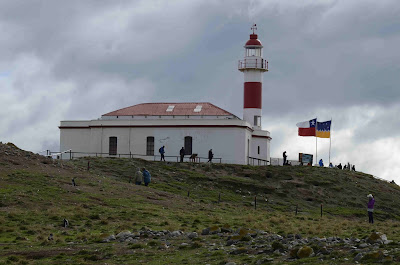The town is proud of its penguins and has signs about them everywhere. Even the local paper is called El Pinguino.
Puenta Arenas, Chile is positioned at the end of the world.
That is unless you are in Ushuaia, Argentina which also claims to be the end of the world. Either way both are near the Magellanic Islands. Both have a lot of birds to see, cool air and nice streets for wandering.
We took a boat named the Skua to Magdalena Island to see those dear penguins.
Before boarding Anna Lee decided she needed something to keep her ears warm. No comments please.
The island is a nature preserve with a trail leading to the lighthouse at the top.
The penguins were unfazed as we wandered up the hill. Only about one third have not gone to sea. These are young penguins still molting.
and adults still preening, getting their feathers oiled for good swimming.
The Magellan Strait penguins migrate to Brazil and Argentina in September. They need the summer daylight to find food. The males arrive first to get the nests in order. The females arrive a couple of weeks later. Males are identified by their larger heads. They nest for about 40 days, leaving in February and March. They live 20-25 years and mate for life.
If one penguin dies, he/she finds a temporary mate and then a new mate.
Nature will have her way. Along with penguins, this is home to skuas and sea lions. Skuas are voracious and indiscriminate eaters. Feathers and skeletons are evidence of this.
South American terns, Upland geese and seagulls all share the area.
These are the Chilean and Magellan Strait flags. The blue is for the sky and the constellations and the yellow for vegetation.
Unfortunately, we have had a change of route as there are gale-force winds blowing around Cape Horn. The captain elected to not to go into the open ocean around the cape and face 60 mph winds so we went through the Beagle Channel. A rainbow gleamed as we passed the southern most point of South America.











No comments:
Post a Comment